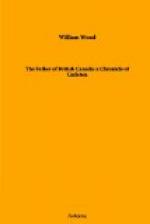The War of the American Revolution was a long and exceedingly complicated struggle; and its many varied fortunes naturally had a profound effect on those of Canada. But Canada was directly engaged in no more than the first three campaigns, when the Americans invaded her in 1775 and ’76, and when the British used her as the base from which to invade the new American Republic in 1777. These first three campaigns formed a purely civil war within the British Empire. On each side stood three parties. Opponents were ranged against each other in the mother country, in the Thirteen Colonies, and in Canada. In the mother country the king and his party government were ranged against the Opposition and all who held radical or revolutionary views. Here the strife was merely political. But in the Thirteen Colonies the forces of the Crown were ranged against the forces of the new Continental Congress. The small minority of colonists who were afterwards known as the United Empire Loyalists sided with the Crown. A majority sided with the Congress. The rest kept as selfishly neutral as they could. Among the English-speaking civilians in Canada, many of whom were now of a much better class than the original camp-followers, the active loyalists comprised only the smaller half. The larger half sided with the Americans, as was only natural, seeing that most of them were immigrants from the Thirteen Colonies. But by no means all these sympathizers were ready for a fight. Among the French Canadians the loyalists included very few besides the seigneurs, the clergy, and a handful of educated people in Montreal, Three Rivers, and Quebec. The mass of the habitants were more or less neutral. But many of them were anti-British at first, while most of them were anti-American afterwards.
Events moved quickly in 1775. On the 19th of April the ‘shot heard round the world’ was fired at Lexington in Massachusetts. On the 1st of May, the day appointed for the inauguration of the Quebec Act, the statue of the king in Montreal was grossly defaced and hung with a cross, a necklace of potatoes, and a placard bearing the inscription, Here’s the Canadian Pope and English Fool—Voila le Pape du Canada et le sot Anglais. Large rewards were offered for the detection of the culprits; but without avail. Excitement ran high and many an argument ended with a bloody nose.




